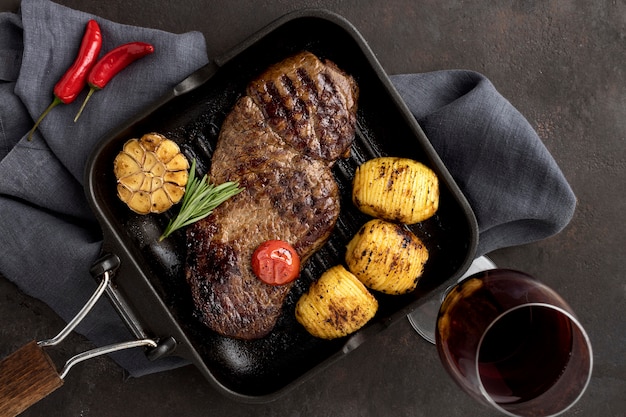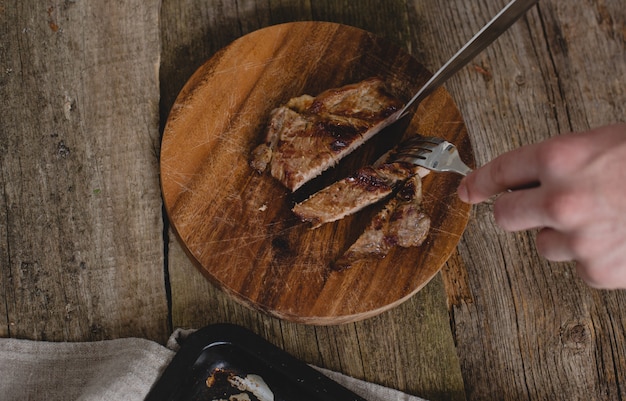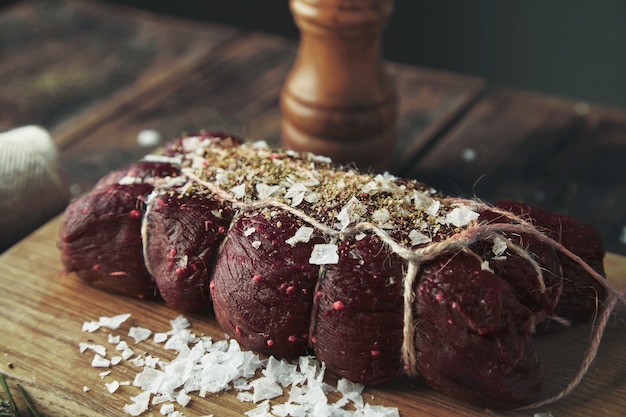Right, let’s talk about corned beef brisket. It’s a bit of a British classic, isn’t it? Those Sunday roasts with all the trimmings, and that glorious, melt-in-your-mouth brisket taking centre stage. I've always held a bit of a fondness for corned beef brisket, but I'll admit, there was a time when I felt intimidated by it. The thought of all that slow cooking, the potential for dryness, the worry of getting it just right… It felt like a culinary Everest. But, you know what? It’s really not that scary at all. In fact, it’s downright rewarding. After countless attempts, and a few kitchen disasters along the way, I’ve finally cracked the code to perfect corned beef brisket. So, grab a cuppa, settle in, and let me share my secrets to achieving that tender, flavorful perfection.
(Part 1) Understanding the Beast

The Lowdown on Brisket
Let’s start with the basics. Brisket, for those who are unfamiliar, is a cut of beef from the chest area of the animal. It’s a tough cut, full of connective tissue and marbling, but that’s what makes it so special! The long, slow cooking process breaks down those tough bits, transforming them into that luscious, melt-in-your-mouth texture that we all crave. It’s a true labour of love, but the reward is well worth the effort. Think about it like this – it's like a tough, rugged piece of leather that, with the right treatment, can be transformed into something beautiful and supple.
Corned Beef: What's the Deal?
Now, corned beef is essentially brisket that’s been cured in a brine, usually containing salt, sugar, spices, and sometimes nitrates. This curing process gives it a distinctive pink hue and a salty, peppery flavour. It's a flavour that's ingrained in many childhood memories, like that classic corned beef hash. But, before you get carried away with your culinary dreams, it’s important to understand that corned beef is already seasoned. So, you don’t want to overdo it with extra salt or spices during the cooking process. It’s a delicate balance, my friends. Imagine it like this – you're working with a canvas that's already been painted with vibrant colours, you just need to add the finishing touches to bring the whole picture together.
(Part 2) Choosing the Right Brisket

Picking a Winner
Right, let’s talk about choosing the right brisket. This is crucial to your success. It’s not just about grabbing the first one you see in the butcher’s shop. You want to make sure you get a good piece. I’m talking about a brisket that's thick and well-marbled. Look for a good balance of fat and lean meat. You want enough fat to keep it moist, but not so much that it becomes overwhelming. Remember, fat is flavour! A good brisket should look like it's been well-loved, not overworked. You're looking for a piece that's got some character.
The Point vs. the Flat
Now, brisket comes in two parts: the point and the flat. The point is the thicker, more rounded part, and it's packed with fat. This makes it incredibly flavorful but can sometimes be a bit tough. The flat is the leaner, thinner part, which tends to cook more evenly. For the best of both worlds, you can go for a whole brisket, which includes both the point and the flat. It’s a bit more work, but trust me, it’s worth it. The point is like a juicy, flavorful steak, while the flat is like a tender, lean roast. Together they create a masterpiece of flavour and texture.
(Part 3) Preparing the Brisket

The First Step: Brining
Okay, now we're getting into the nitty-gritty. Before you even think about cooking, you need to give your brisket a good soak in a brine. This is essential for bringing out the flavour and tenderness. You can buy pre-made brines, or you can whip up your own. There are loads of recipes online, and you can experiment with different herbs and spices. But, my secret weapon is a simple brine of salt, sugar, peppercorns, and bay leaves. I like to let the brisket soak for a good 24 hours in the fridge. The longer, the better, as it allows the flavours to really penetrate the meat. Think of it like marinating a steak, but on a grander scale.
Rinsing and Trimming
After the brine bath, it’s time for a good rinse. You want to get rid of any excess salt and debris. Then, it’s time to trim the brisket. Now, don’t go overboard here. You want to remove any excess fat and any thick, tough pieces. But leave a good layer of fat on top of the brisket. This is your protective barrier, preventing the meat from drying out during cooking. Think of it as a natural shield. This step is about refining your raw material, preparing it for the journey ahead.
(Part 4) The Grand Cook-Off
Slow and Low: The Key to Success
Alright, the moment we’ve all been waiting for - the cooking! Now, when it comes to corned beef brisket, slow and low is the way to go. You want to cook it at a low temperature, around 275 degrees Fahrenheit, for a long period of time. This allows the collagen and connective tissue to break down, resulting in a gloriously tender and juicy brisket. The slow and low method, my friends, is the secret to that perfect fall-apart texture. It’s not a race, it’s a marathon, and patience is your best friend. The slow cooking process is like letting the brisket simmer in its own juices, allowing the flavours to deepen and the textures to soften.
The Magic of the dutch oven
Now, there are a couple of ways to cook your brisket. You can go for the traditional oven method, or you can use a Dutch oven. I prefer the Dutch oven because it creates a lovely, moist cooking environment. Plus, it’s much easier to maintain a consistent temperature. But, whatever method you choose, make sure you use a cooking thermometer to check the internal temperature. You’re aiming for an internal temperature of 190 degrees Fahrenheit for the most tender, juicy brisket. That’s the magic number. The Dutch oven is like a culinary hug, keeping the brisket warm and cozy during the long cooking process.
(Part 5) Flavor Boosters: Adding the Extras
The Power of Aromatic Vegetables
You can stop there, but if you really want to up your brisket game, why not add some flavor-boosting ingredients to the mix? Think about adding a few aromatics like onions, garlic, carrots, and celery. These vegetables not only add a lovely depth of flavour to the brisket but also help to create a delicious sauce that you can drizzle over your finished dish. It’s a win-win situation. It's like adding a symphony of flavours to an already impressive melody.
The Art of Liquid: Water, Beer, or Broth
Now, you also need to add some liquid to the cooking process. This prevents the brisket from drying out and helps to create a lovely sauce. You can use water, beer, or even broth. I like to use a combination of water and beef broth for a richer, more flavorful sauce. And don’t forget the herbs and spices. A little bit of thyme, rosemary, or bay leaves can go a long way in adding complexity to your brisket. The liquid is like a supporting actor, providing moisture and enhancing the star of the show, the brisket.
(Part 6) The Final Stages: Resting and Slicing
Letting it Rest
Okay, so you’ve cooked your brisket to perfection. But don’t rush to slice it right away! It’s crucial to let it rest for at least 30 minutes before slicing. This allows the juices to redistribute throughout the meat, resulting in a more tender, flavorful brisket. Think of it as a little time for the brisket to recover from the long journey. It's like giving a masterpiece a moment to breathe before unveiling it to the world.
Slicing the Brisket
Now, it's time for the big reveal. Get your sharpest knife ready, because you’re about to carve the star of the show. Slice the brisket against the grain. This means slicing across the direction of the muscle fibers. This will help to prevent the meat from being tough and stringy. Remember, it’s all about that melt-in-your-mouth texture. Imagine slicing through a soft, buttery cake, each bite a delightful revelation.
(Part 7) Serving Up Your Masterpiece
The Perfect Accompaniments
Your corned beef brisket is ready to be enjoyed! And what better way to celebrate your culinary triumph than with some delicious side dishes? You know, the classics that always complement brisket so well. Think about a creamy coleslaw, some fluffy mashed potatoes, a vibrant green salad, and, of course, some crusty bread for soaking up all that delicious sauce. It’s a feast fit for a king. Each side dish is like a supporting actor, adding to the overall performance of the brisket.
The All-Important Sauce
Don’t forget the sauce! That luscious, flavorful liquid that’s been bubbling away in the Dutch oven is the perfect finishing touch. You can drizzle it over the brisket, serve it on the side, or even dip your bread in it. It's a symphony of flavour that will tantalize your taste buds. The sauce is the final flourish, a burst of flavour that brings the whole dish together.
(Part 8) Beyond the Plate: Leftover Love
Turning Leftovers into Delights
Okay, let’s be honest, you’re bound to have some leftover brisket. And that’s a good thing, because it means you have more opportunities to enjoy your culinary masterpiece. Leftovers can be just as delicious, if not more so, than the original meal. You can whip up a hearty corned beef hash, a classic reuben sandwich, or even add it to a hearty soup. The possibilities are endless, so get creative! It's like discovering new hidden gems in a treasure chest of flavors.
(Part 9) FAQ Corner
Q1: How Long Does Corned Beef Brisket Last in the Fridge?
Corned beef brisket can be stored in the fridge for up to 4 days. Just make sure you wrap it tightly in plastic wrap or aluminum foil. But if you want to extend the shelf life, you can freeze it for up to 3 months. Just thaw it in the fridge overnight before cooking. But, let’s be honest, it’s unlikely to last that long! It’s too delicious to resist. The refrigerator is like a culinary time machine, allowing you to enjoy the flavours of your brisket even after the feast is over.
Q2: How Do You Know if Corned Beef Brisket Is Done?
You’ll know your corned beef brisket is done when it reaches an internal temperature of 190 degrees Fahrenheit. You can use a meat thermometer to check the temperature. Another way to tell if it’s done is by using the “fork test.” If you can easily insert a fork into the brisket and it pulls away cleanly, it's ready to be enjoyed. The meat should be tender and pull apart easily. Think of the fork test as a gentle interrogation of the brisket, revealing its true nature.
Q3: Can I cook corned Beef Brisket in the slow cooker?
Absolutely! You can cook corned beef brisket in a slow cooker. Just follow the same instructions as for the Dutch oven, but make sure you have enough liquid to cover the brisket. Cook on low for 8-10 hours, or on high for 4-6 hours. But remember, slow cookers vary in size, so you may need to adjust the cooking time accordingly. The slow cooker is like a patient guardian, gently nurturing the brisket into a culinary masterpiece.
Q4: What Are Some Good Substitutes for Corned Beef Brisket?
If you can’t find corned beef brisket, you can use a regular brisket. Just make sure you cure it in a brine before cooking. You can also use a chuck roast or a shoulder roast. These cuts are also tougher and benefit from slow cooking. They’ll just have a slightly different flavour profile than corned beef. Think of them as alternative paths to culinary excellence, each with its own unique flavour.
Q5: What Are the Best Herbs and Spices to Use with Corned Beef Brisket?
The classic herbs and spices to use with corned beef brisket are bay leaves, black peppercorns, allspice berries, and coriander seeds. You can also add a pinch of cinnamon or cloves for a touch of sweetness. But remember, the corned beef is already seasoned, so you don’t want to overdo it. Just add a few sprigs of herbs or a sprinkle of spices to enhance the flavour, not overpower it. Herbs and spices are like a finishing touch, adding a subtle touch of complexity to the already delicious brisket.
There you have it, my friends. The ultimate guide to tender, flavorful corned beef brisket. It's not as intimidating as it may seem. With a little patience, a dash of creativity, and a good dose of love, you can create a culinary masterpiece that will impress even the most discerning palates. So, go on, get in the kitchen, and let the magic unfold. Happy cooking!
Everyone is watching

How to Cook Frozen Lobster Tails Perfectly: A Step-by-Step Guide
RecipesLobster. Just the word conjures up images of lavish meals, special occasions, and a taste of luxury. But let's...

Pigs in a Blanket Cooking Time: How Long to Bake for Perfect Results
RecipesAh, pigs in a blanket. Just the name conjures up images of those delightful little parcels of crispy pastry en...

Pork Fillet Cooking Time: How Long to Cook It Perfectly
RecipesPork fillet, or tenderloin as it's sometimes called, is a real favourite in our house. It's so versatile, and...

The Ultimate Guide to Cooking Sweet Potatoes: From Roasting to Mashing
RecipesSweet potatoes. Just the name conjures up images of warm, comforting dishes, bursts of vibrant color, and a to...

The Ultimate Guide to Tender, Juicy Pulled Pork
RecipesRight, let's talk pulled pork. It's one of those dishes that just screams "comfort food," doesn't it? I mean...
